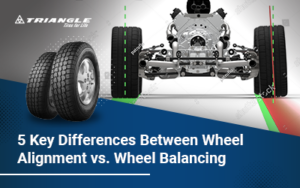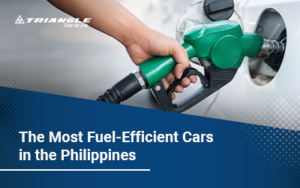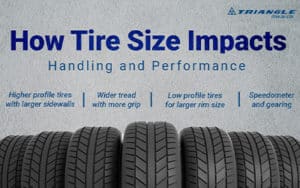Gas and diesel⎯vital to a vehicle’s operation⎯are becoming more expensive by the day. No wonder many drivers go out of their way to try fuel-saving methods.
Here’s a valuable insight—your tire fuel efficiency rating is crucial to your vehicle’s consumption, and knowing the relationship between tires and fuel economy can save you more money in the long run. So, read on to find out how your tires affect fuel economy and pick up practical tips for improving tire fuel efficiency.
5 Features Affecting Tire and Fuel Economy
Let’s start by defining rolling resistance, which determines how your tires influence fuel economy. A stationary object naturally requires energy to move, so a car resistant to movement will burn fuel quickly. Tires primarily affect this variable—those that deteriorate as they roll on the road consume more energy, while stiffer ones are more efficient.
Having said that, here are tire features affecting rolling resistance and your car’s fuel economy.
1. Tire pressure
Tire pressure impacts how efficiently your vehicle rolls down the road. Underinflation leaves a depression along the treads’ middle, while overinflation bloats it; both reduce the tire’s surface that makes contact with the ground. The latter also places unnecessary stress on the rubber, shortening its lifespan and increasing the likelihood of failure and blowouts.
2. Tire treadwear
Treadwear refers to how quickly your tires wear down and need replacing. You’ll often find your tires’ treadwear rating on their sidewall. A higher figure is ideal; tires with an 800 treadwear usually last twice as long as their 400-rated counterpart, making them more fuel efficient. Treadwear ratings above 800 are also ideal for trucks and commercial vehicles due to their standard usage.
3. Tire size
Large, heavy tires generally have a high rolling resistance and, in turn, low fuel economy. Then again, these factors still depend on driving conditions. Smaller tires are better in stop-start traffic because they require minimal power to roll. However, on freeways and at high speeds, they cover less ground than larger tires and demand more fuel, so the latter is your best option.
4. Nitrogen gas
Many drivers may think filling tires with nitrogen gas extends the rubber’s lifespan, boosts handling, and improves fuel economy. It’s partly true—nitrogen atoms are larger than oxygen, so they leak slower, although the difference is arguable.
Also, external temperatures don’t affect tire pressure because nitrogen is unreactive to its environment, reducing the time between reinflating tires. Due to this factor, nitrogen-filled tires are often beneficial for semi-trucks and other specialty vehicles, which drivers can’t constantly maintain.
So, if you drive a standard car, buying nitrogen will cost you more without little to no impact on tire performance and fuel economy.
5. Wheel type
The type of wheels on your vehicle influences its fuel consumption. For instance, those made from heavier metals⎯such as stock wheels⎯demand more energy to roll on the road than other options. It’s even worse when you have hub caps. Thankfully, aftermarket wheels made from thinner and lighter alloys significantly reduce vehicle weight and make driving more manageable for your engine.
5 Ways to Improve Tire Fuel Efficiency
After knowing what tire features impact your vehicle’s consumption, it’s time for practical tips to improve fuel efficiency.
1. Make sure your tire pressure is right
Did you know properly inflated tires improve mileage by up to 3%? Check your tire pressure regularly and keep it within the manufacturer’s recommendation for optimal performance and efficiency. You can find this information on a sticker on the driver-side door, the vehicle’s handbook, or the tire’s sidewall.
2. Check your wheel alignment
Poor wheel alignment pulls your vehicle to one side when moving, adding unnecessary resistance and increasing fuel consumption in the long run. Even worse, it can undermine your steering and lead to accidents. As such, ensure all four wheels are perpendicular to the ground and parallel to each other by checking the following angles:
- The camber is the tire’s inward or outward angle when you view it from the front.
- The toe is the inward or outward angle from above.
- The caster is the steering axis from the vehicle’s side.
3. Choose the appropriate tires
Your tires should meet your driving demands. Low-resistance options, such as those with high treadwear ratings, improve your fuel economy significantly. So, pick tires with treads that fit your usual driving routes. Shallow ones are typically more fuel-efficient, while tires with deep grooves are not as ideal, especially when you aren’t off-roading.
4. Assess your tire structure
The stock wheels that come with your vehicle upon purchase are often heavy. Consider swapping them with lighter alloys to reduce rolling resistance and improve your car’s overall fuel consumption. You can also opt for thinner sidewalls and narrower tread patterns, as they weigh much less than stocks. Again, avoid large off-roading tires that might only drag your car down.
5. Decrease your carrying capacity
The load index indicates your tires’ maximum load capacity. High-load tires support large vehicles and cargo, making them generally thicker and more structured. However, it also means they’re heavy and add significant rolling resistance to your car. Reduce fuel consumption by switching them with light-load tires when you aren’t carrying heavy goods or driving a large vehicle.
Save More with the Best Tires
Nowadays, fuel prices make filling up a headache for many drivers, so do your best to minimize your consumption by adjusting your tires. On top of that, maintaining the proper air pressure, wheel size, and alignment can do wonders for your car’s fuel economy, so you can go further and beyond without worrying much about costs.
Are you looking for fuel-efficient tires that won’t break the bank? Triangle Tires can help. We have a wide selection of quality tires for any purpose—from passenger cars and light trucks to heavy equipment vehicles—available for delivery at an affordable price.
Browse our tire catalog, or contact us for your tire needs.


